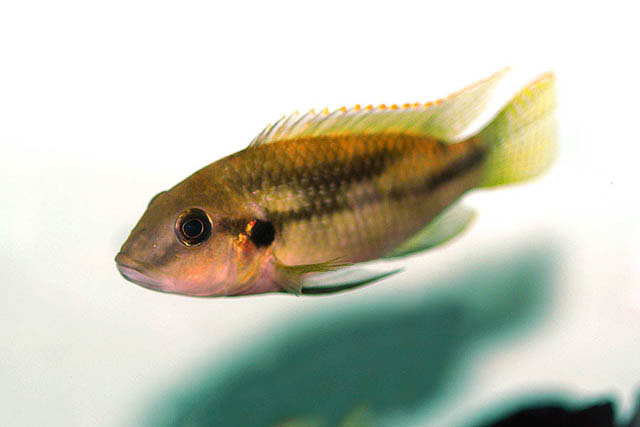| Cichlidae (Cichlids), subfamily: Pseudocrenilabrinae |
| 7.33 cm SL (male/unsexed) |
|
benthopelagic; freshwater |
| Africa: rivers and creeks around Mount Cameroon and the middle Mungo system (Cameroon) (Ref. 52307, 81260). |
|
Dorsal spines (total): 14-16; Dorsal soft rays (total): 9-11; Anal spines: 3-3; Anal soft rays: 6-8. Diagnosis: dorsal fin membrane pale, without dense black band; no strongly marked vertical bars on flanks; males with rows of dark maculae over entire caudal membrane; stressed individuals with characteristic pattern of 2 conjugating longitudinal bands (Ref. 81260).
Description: body depth 33.1-38.8% SL; head length 34.7-38.1% SL; caudal peduncle deeper than long; some dorsal and anal fin rays elongated; caudal rounded in both sexes (Ref. 81260).
Coloration: body yellow-brown to ochre, paler ventrally (Ref. 52307, 81260). Stressed individuals usually with 2 horizontal bands (Ref. 52307, 81260): one at mid-body, the second about 2 scale rows below dorsal fin (Ref. 81260). These bands are always conjoined at mid-body level forming a very characteristic conjoined patterning (Ref. 52307, 81260). Dorsal and upper part of caudal with red margins; females with chrome-colored region in soft dorsal, upper third of caudal often also chrome-colored but normally only between fin rays, so that this part of the caudal fin appears banded (Ref. 81260). Males with numerous rows of dark maculae over entire caudal fin, often also in soft dorsal and anal; body scales in males with black margins; cheek and opercle with bluish/turquoise or green iridescent flush; some individuals with red coloration on upper lips (Ref. 52307, 81260). Lower lips white or yellow; juveniles with "tilapia spot", which may be retained in adults (Ref. 81260). Belly of ripe females with rosy coloration (Ref. 52307, 81260). |
| Pair-bonding, ovophilic mouthbrooder (Ref. 52307, 81260)with delayed uptake (Ref. 81260). Spawns on open substrates (Ref. 81260). Biparental, i.e. both parents brood offspring (Ref. 52307, 81260). |
|
Endangered (EN); Date assessed: 16 February 2009 (B1ab(iii)+2ab(iii)) Ref. (130435)
|
| harmless |
Source and more info: www.fishbase.org. For personal, classroom, and other internal use only. Not for publication.
